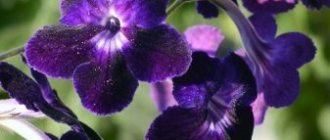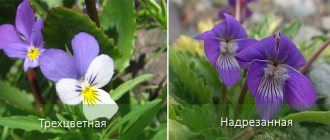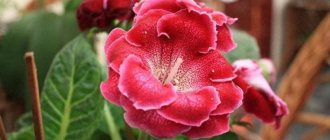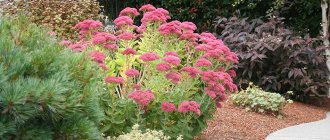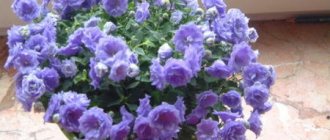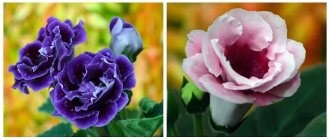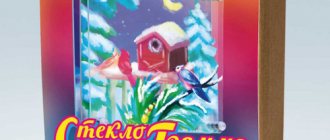Anthurium - features and description of a garden flower
This crop, also called “Flamingo flower,” is one of the most popular species of the Araceae family. The variety of forms allows you to grow it as a houseplant or garden plant. There are also some varieties, the description of which suggests breeding specifically for cutting, for sale in bouquets and bright compositions.
Anthurium leaves are leathery, massive, can be solid or dissected, most often dark green, with a monochromatic or multifaceted pattern on the surface, it depends on the shape and the specific variety. The flowers are beautiful, they come in blue, white, red, orange, and take on almost all variegated shades - lilac, violet, purple. Regardless of the type, they have a pronounced and pleasant aroma.
The flower is considered relatively unpretentious, unlike many other tropical forms. The main thing is to follow the basic rules of care, water, feed and monitor the condition of the plant on time. It is often used in greenhouses and as an original part of bright landscape design. Only from a few different varieties can you create a unique and beautiful composition in the garden or indoors.
Indoor anthurium is considered a masculine flower; it is not without reason that people call it nothing more than “Men’s Happiness.” There is a belief that a bright flower given to the stronger sex brings its owner a positive surge of emotions and strength, and brings a lot of passion and love to the lovers’ home.
Review of popular plant varieties
Anthurium Andre. One of the most popular species with many hybrid forms, which is represented in nature by an epiphytic flower from the mountain forests of Colombia and Ecuador with short stems and aerial roots. The leaves are bright green, quite large in size, in the shape of a glossy heart, reaching up to 20 centimeters in width and up to 50 in length.
The flower is represented by a large “cob” of bright yellow or cream color with a leaf-spread of a variety of colors, from white-pink to burgundy-red, depending on the specific hybrid. The flowering period is about 1.5 months; at the end, the massive part of the inflorescence takes on a light green color. The most popular subspecies are: Arizona, Polaris, Pink Champion, Marasol, Cuba.
Baker's Anthurium. Another well-known variety with a short stem (up to 0.5 meters) and long, narrow leaves that take on a “belt-like” shape. The inflorescence is massive, on it grows a spadix of a cream or bright yellow color with a bright green spathe with purple edges. Very picky about care. In order for it to grow properly and delight the owner with its wonderful aroma, it is worth providing conditions as close to tropical as possible, strictly observing the temperature and quality of watering.
Crystal (majestic). Perhaps the most beautiful and spectacular of all types of anthurium that can be grown at home. The plant is characterized by a short, underground stem and velvety, green leaves with silvery veins on the outside that have a bright, crystal luster. Bracts are very sensitive to temperature changes and especially to low temperatures; for normal cultivation it is necessary that the room always be at least 17-18 degrees.
Anthurium Scherzer. Epiphytic plant with non-shiny, leathery dark green leaves. They have several variants of shapes and are dotted with dots of black or other shades on both sides of the leaf plate. The cob is twisted in a spiral, red, yellow or bright orange; the spathe is dense, bright, and most often takes on an elliptical shape. Among the most common indoor types are:
- Arinos, Smaragd, Unica with a green flower cover;
- red Artus, Rustica or Hannah;
- Lacetti with a bright pink flower and an orange spiral in the center.
In addition to the species presented, varieties and varieties of anthurium such as Climbing, Hooker Flower, Violet, and Dissected are also popular for growing in gardens or greenhouses.
Anthurium - description of the plant
The lanceolate-shaped leaves are dark green in color with a pointed end, leathery to the touch. There is a main vein along its length. The stems have aerial roots, which gives the anthurium an exotic shape. There are more than 900 species in nature. We will focus only on the basic ones that are widely used at home. This is perhaps one of the largest plants of the aroid family.
Flowering at home can cause a lot of trouble. It has taken root well in greenhouses with individual heating. Anthurium requires relatively high constant temperature and high humidity. When purchased, the plant has buds and glossy leaves.
Flower propagation by seeds and cuttings - rules for beginners
To obtain high-quality planting material at home, it is best to pollinate a houseplant yourself, that is, transfer pollen from one fruit to another. This procedure is performed several times with an interval of 2-3 days. The seeds are removed from the young fruit, then they are treated in a weak solution of potassium permanganate and sent to the refrigerator for storage in special paper containers.
Ripening time is from 6 to 8 months. As soon as the material is ready, it is immediately planted in suitable, fresh soil. It should be loose, with a sufficient amount of garden soil, peat, and the top layer should be covered with perlite or river sand. The seeds are carefully laid out on the surface at a distance of 2-3 centimeters from each other and then slightly pressed onto the soil from above.
The container with the planted seeds is covered with a thin plastic film or glass and left for 1-2 weeks in a dry room at a temperature of 22-23 degrees. The first shoots appear just 10-14 days after planting. As soon as a couple of real, green leaves have appeared, the seedlings are planted in larger pots with new soil, which, in addition to the main components, should also include coniferous and forest soil.
In the future, picking is carried out several more times as the plant grows and develops. With proper care, the first flowering indoors will occur 3-4 years after planting.
Vegetative propagation involves the use of cuttings or layering (stem suckers) from the mother plant. The lateral or upper shoots of a healthy and active specimen are carefully separated from the trunk and placed in separate containers. If the root system on the resulting cuttings is weak, then they must be rooted before planting.
To do this, they are planted in perlite or river sand, covered with polyethylene and placed in a warm room for 2 weeks. After the roots appear, the finished shoots are planted in fresh, fertile soil, as is the case with seeds.
Anthurium propagation
Anthurium propagates in several ways: by seeds, by dividing the bush, by lateral shoots, stem and leaf cuttings.
Anthurium propagation by dividing the bush
Propagation is performed using this method when replanting a plant. After removing the anthurium from the pot, carefully divide it, trying not to damage the fragile, easily broken roots. Each part resulting from division must have roots and a growing point. The divisions are planted in pots filled with drainage material and substrate for anthurium. Care for the planted sections as if they were adult plants. If kept in good conditions and cared for, young anthuriums will bloom this year.
Anthurium propagation by lateral shoots
In an adult plant, shoots form on the sides, which can be separated from the central stem during spring replanting. Do not try to remove them from the pot without digging up the anthurium itself: the roots of the plant may be severely damaged. The plant removed from the flowerpot is freed from side shoots, which are immediately planted in the substrate, placed in a warm, humid place and covered with a cap. For rooting, shoots need bright, diffused light, daily ventilation and spraying. After a month, the rooted side shoots of the anthurium can be planted in a permanent place.
Anthurium propagation by cuttings
This is a fairly easy way to get another anthurium. Separate from an adult plant a leaf with a piece of stem 5-8 cm long and a growing point, dry the cut for about ten minutes, remove the leaf and place the cutting with the cut in water or in a mixture of equal parts of sand and peat, or in damp compressed sphagnum. As soon as the resulting roots reach 2-3 cm in length, the cuttings can be planted in the ground.
Such types of anthurium as thick-veined, Andre, leathery and Scherzer can even be propagated by leaf cuttings: cut off the upper part of the petiole up to 3 cm long with a leaf, roll the leaf into a tube, fix it in this position with an elastic band and immerse the cutting in a mixture of sand and peat in equal amounts parts to such a depth that only a third of the folded sheet remains outside. Water the substrate, cover the cutting with a half-liter jar and place it in a warm, shaded place. While the cutting grows roots, it needs to be ventilated and sprayed. In three weeks, a young sprout will appear from the tube, but it will be possible to transplant it to a permanent place no earlier than in a month.
How to grow anthurium from seeds
The seed method of propagating anthurium is rarely used, since there are several convenient and reliable vegetative methods that give faster results and preserve the properties of the parent plant in young anthuriums. But those hobbyists who hope to obtain new varieties and hybrids resort precisely to the generative method of propagation.
Seeds of hybrid or varietal anthuriums are sold to specialized gardening centers. When purchasing, look at the expiration date indicated on the package: anthurium seeds remain viable for only three months. To get seeds from your own anthurium, you will have to artificially pollinate the plant.
For sowing, it is better to use bowls filled with peat. The seeds are laid out on the surface and sprinkled on top with a layer of peat 2-3 mm thick, after which the crops are sprayed with a fine spray bottle, placed in a warm place and covered with a transparent cap. Shoots may appear in a week, or maybe in two, but the covering is removed only after a month, when the seedlings develop their first true leaf. At the stage of formation of the third leaf, anthurium seedlings dive into a planting box or in separate cups filled with a substrate of crushed charcoal, peat and leaf soil in equal parts. If you don’t have time to tinker with preparing the substrate, buy soil for flower seedlings at the store. Caring for seedlings consists of regularly moistening the substrate, daily spraying and feeding the seedlings with liquid fertilizers diluted with water twice as much as recommended by the manufacturers. Grown seedlings are planted in pots with a diameter of 10 cm, in which the drainage material should occupy a third of the pot. The substrate will need the same composition as for an adult anthurium.
Replanting in an apartment - stages and soil selection
Anthurium is replanted at least once every 2-3 years as needed. This is done either from February to March, or from May to August during the summer season. With each transplant, a new container is taken so that it is 1-2 centimeters more spacious than the previous one.
It is imperative to replant immediately after purchasing the plant, after 1-2 weeks, especially if the root part breaks through the drainage compartment in the pot.
A mandatory drainage layer of small particles of brick or expanded clay is laid out at the bottom of the new container. The soil is loose, moisture-permeable, consisting of peat and turf soil, and the aerial roots of the plant are covered with moss to make it easier to moisten them. To increase soil fertility, it is also recommended to add river sand, pieces of pine bark or charcoal to the main components.
A soil that consists entirely of pine bark and pine needles with the addition of a small amount of coarse peat and expanded clay for a drainage layer is also suitable for anthurium. If you transplant a flower only into pine soil, you will have to moisten it more often and apply more fertilizer.
Anthurium care - temperature and watering
The first step is to properly organize lighting for an indoor flower. It feels good on east or west windows in an apartment or house, as it prefers, although bright, diffused light.
The main thing is to avoid frequent exposure to direct sunlight, especially on the leaves and stems of a young plant. Therefore, if the anthurium is on the south side, the windows are additionally covered with a curtain or newspaper in the summer. Maintaining optimal temperature conditions is also important. This tropical plant is very thermophilic; in spring and summer the t level is kept within 22-28 degrees.
Lowering this indicator below 18 degrees, and especially for a long time, is unacceptable, this will lead to diseases and wilting of the flower. It is also not recommended to allow sudden changes, and from the beginning of October to February in the room with anthurium, a comfortable temperature for this time of the season is set within +16-+18.
When growing the Scherzer variety from December to the end of January, it is necessary to artificially lower the temperature to 12-13 degrees. This is necessary to ensure high-quality and long-lasting flowering. Water the flower abundantly, immediately after the top of the soil dries.
For irrigation use warm, settled or rain water. After the procedure, be sure to drain the excess liquid that has accumulated on the drainage pan so that its stagnation does not lead to rotting of the delicate aerial roots.
This crop also loves additional spraying of the green part, especially in hot summer weather. To do this, wipe the stems and leaves with a cloth soaked in water or carefully spray the liquid from a spray bottle, trying not to touch the flowers and inflorescences, since during active flowering excess moisture can contribute to the formation of stains on the beautiful “bedspreads” of the flower, which reduces the overall decorativeness of the plant.
Anthurium - species with photo and name
Anthurium andraeanum
Located in Southwestern Colombia, Ecuador. Prefers mountainous areas with a humid subtropical climate. It has short stems and aerial roots. Large green lanceolate leaves up to 40 cm long. Flowers are collected in an inflorescence into a spadix. The spadix is creamy white and up to 10 cm long. Leathery blanket. Flowers last up to 4 weeks.
Anthurium leuconeurum Lem
Native to Mexico with large, ovate-shaped leaves.
Baker's Anthurium
Prefers tropical rain forests of Colombia and Guatemala. An epiphytic plant with dense narrow leaves up to 0.5 m long and up to 10 cm wide. The reverse side is covered with brown spots. Leathery cover of green-yellow color. The cob is creamy, up to 10 cm in length. The fruits are red berries.
Majestic (magnificum Linden)
Epiphyte from Colombia. Bright green leaves with distinct veins in a branched pattern. Sharp tetrahedral edges.
Anthurium Hooker (hookeri Kunth)
Habitat: Antilles, Skrinam. Large bright green leaves are collected at the base into a rosette. The peduncle reaches 1 m. White berries and red tops.
Anthurium climbing (scandens)
From Mexico and Brazil. Thick roots and stems, up to 1 m long. Leathery leaves are lanceolate-shaped. Bottom covered with small dots. Red petioles up to 2 cm. Yellow-green cob. Fruits with white and purple berries. Easily tolerates dark areas.
Multidissected (polyschistum Schult)
Habitat Peru, tropical forests - liana. Peduncle up to 30 cm with a smooth spathe and spadix, white-violet fruits.
Crystal (crystallinum)
The homeland is considered to be the region of Panama, the mountain tropics. Epiphytic anthurium with a short caudex and velvety leaves up to 40 cm long and up to 20 cm wide. The surface is covered with a crystal luster. Round, smooth petioles. The peduncle reaches 40 cm.
Scherzer (Anthurium scherzerianum)
Lives in Costa Rica. Prefers a humid climate, growing at an altitude of 1000 to 2000 m above sea level. Short stems. Dark green, lanceolate-shaped, leathery leaves. The peduncle reaches half a meter.
Fertilization and care during flowering
For normal growth and development throughout the calendar year, anthurium must be fed in spring and summer with mineral fertilizer complexes for indoor flowers and ornamental plants. The culture feeding period is 1-2 times every 2 weeks. Foliar fertilizing can be applied more often, and the best organics for this home plant are infusions of natural chicken manure or mullein with water, as well as complex biostimulants Zircon-M, Epin and others.
Anthurium flowering with proper care can last from 1 to 3 months, that is, throughout the summer. Some hybrids of the Andre variety are capable of delighting with their beautiful fruits both in spring and the first half of autumn. To ensure that young flowers are bright and saturated, faded shoots are cut off every autumn season, and directly during active flowering the crop is additionally pollinated, transferring pollen in several stages from one flower to another using a soft fabric brush.
Remember that, despite its decorative value and pleasant floral aroma, anthurium belongs to the class of poisonous indoor plants. Leaves, inflorescences and fruits should have an exclusively decorative function; their contact with pets or small children is not allowed, especially during the period of active flowering.
Read about a super beautiful plant - indoor gerbera.
Disease and pest control - prevention and treatment
Anthurium, like many tropical relatives, is a delicate plant. Due to waterlogging or stagnation of water in the lower part of the pot, the roots suffer from various types of rot, which is very difficult to combat. Therefore, after each watering, make sure that there is as much moisture as the flower needs at a certain moment.
The first sign of rot is yellowing of the leaves. If this happens, complex treatment and complete replanting of the plant is necessary. The flower is removed from the soil, cleaned, all rotten roots are cut off, washed with water, allowed to dry, then replanted in completely new soil. Next, scheduled watering is carried out, after which the soil is treated with bioregulators or various growth stimulants and preventive agents on a natural basis.
When leaves turn black at the edges, you should think about the quantity and quality of fertilizing. This usually occurs due to an excess of calcium in the soil, which means the amount of mineral and especially organic fertilizers must be reduced by at least half or stopped completely.
If the leaves dry out and curl, the flowers do not open well, which means you need to check the conditions. Perhaps the plant is in a draft or is exposed to constant temperature changes. Once again check the condition of the soil, the degree of its moisture content, and, if necessary, carry out preventive replanting. When pests appear in the form of aphids, spider mites or scale insects (on garden forms of anthurium), immediately treat the flower with high-quality double-action insecticides.
If you follow the basic rules of maintenance, watering and timely application of fertilizers, the anthurium will grow healthy and strong and will delight its owner with a pleasant, summer aroma and original appearance.
Pests and diseases of anthurium
Anthurium diseases
In general, anthurium is not considered a painful plant: all its problems are mainly associated with improper or insufficient care. Sometimes the plant may suffer from an infection spread by pests. Among fungal diseases, anthurium can be affected by rust, powdery mildew, gray mold, fusarium, anthracnose, septoria and gommosis. Rooting of the roots is caused by soil fungi, the activity of which occurs due to waterlogging of the substrate, sharp temperature fluctuations and too high air humidity against the backdrop of extreme heat. How to treat anthurium for fungal diseases? First of all, it is necessary to establish the cause of the disease, that is, find out which point in caring for the plant you have violated, eliminate this cause, and then carry out one or more treatments of the anthurium with a fungicide solution until complete recovery.
Sometimes the leaves and flowers of anthurium are covered with a black coating - a sooty fungus, the favorable environment for which is honeydew, or honeydew - the waste of some harmful insects. If anthurium is infected with sooty fungus, you will have to fight the infection and at the same time get rid of sucking pests.
Anthurium pests
The main enemies of anthurium among insects are thrips, aphids and scale insects - sucking insects that feed on the cell sap of the plant. It is difficult to fight scale insects, because adult individuals are covered with a reliable shell that protects them and the eggs they lay from any insecticide. Therefore, you first need to remove the scale insects from the anthurium mechanically: take a cotton pad, moisten it with alcohol or soap solution and remove the scale insects from the plant. They usually hide on the underside of leaves. You can remove scale insects from hard-to-reach places with an ear stick. After mechanical cleaning of pests, treat the anthurium with an insecticide solution - Actellik, Karbofos, Aktara, Derris or another preparation of similar action.
Thrips and aphids should be treated with an insecticide as soon as you find them, since they reproduce very quickly and easily move from one plant to another. The same means are used against them as against scale insects.
But the most dangerous pests for any house plant are spider mites. Fortunately, they rarely parasitize anthurium: this plant needs high air humidity, in which spider mites cannot live. If they appear on your flower, this means that the anthurium is in conditions that are unacceptable for it. Ticks are killed with acaricides, since they are not insects, but arachnids. The best anti-tick medications are Actellik, Fitoverm, Neoron, Actofit, Vermitek, Fufanon and Akarin.
Why does anthurium turn yellow?
Anthurium reacts to poor care or improper location with its leaves: when there is poor lighting or an excess of nutrients in the soil, its leaves turn yellow or turn pale. Anthurium leaves also turn yellow when the watering regime is disrupted, that is, if you chronically over-moistened the substrate in which the flower grows, and this led to rotting of its roots. Determine the cause of the phenomenon and eliminate it, and remove the yellow drying leaves. If the roots of the plant are diseased, you need to remove the flower from the pot, cut off all rotting areas from the roots, treat the cuts with crushed coal, ground cinnamon or wood ash and transplant the anthurium into a fresh substrate. Yellowness on the leaves may also appear when the pot becomes too small for the plant.
Why does anthurium dry out?
These symptoms occur when the plant is not watered enough or the air humidity in the room is low. Correct the mistakes, cut off the dry leaves, and the anthurium will become healthy and attractive again. Anthurium leaves also dry out when infected with anthracnose, which can be cured with fungicidal drugs.
Spots on anthurium leaves
You already know why yellow spots can appear on anthurium, but what causes brown spots on the leaves of the plant? Firstly, they can appear due to too frequent or excessive watering, especially if you use cold water for humidification. Secondly, the cause may be an incorrectly selected substrate. Thirdly, spots can occur if the roots are damaged when replanting the plant. And sometimes spots appear due to the fact that the roots of the anthurium freeze on a cold windowsill or because of infection with aphids or septoria. Find out what exactly is the reason, eliminate it, and remove diseased leaves.
Black spots on anthurium leaves also appear due to several reasons: too low or too high a room temperature, dry air, drafts, excess calcium in the soil or direct sunlight on anthurium leaves.


